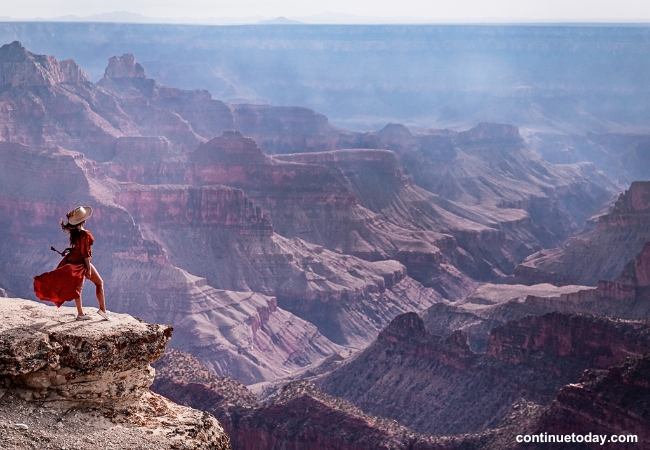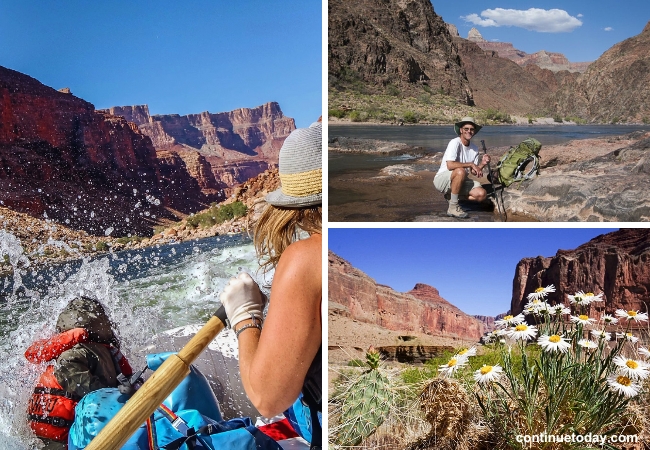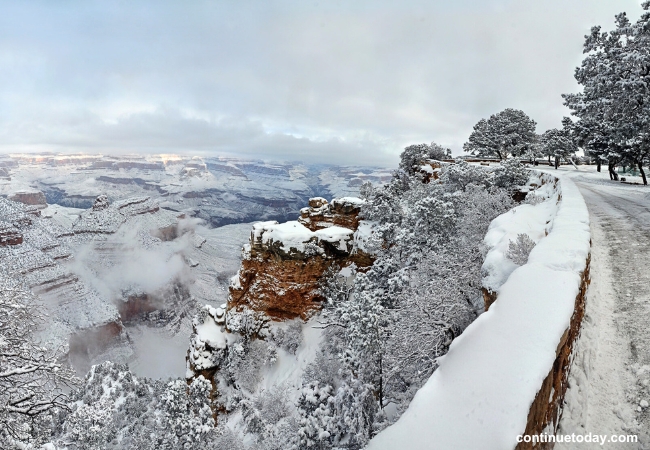The best seasons to visit in Grand Canyon depend on what you want to do when you’re there. Before booking a flight, consider what activities you will do the most. Then choose the best time to travel.
The best times to visit in Grand Canyon are during the spring and fall seasons. It depends on your reasons for visiting the legendary northern Arizona landscape. We’ll break down each season monthly to find the best time to visit in Grand Canyon.
If your main focus is to see the beautiful views and take photos at the Grand Canyon, you have more freedom in choosing when to visit. However, certain activities like camping, hiking, and rafting are more convenient and less expensive to arrange during specific months.
Whatever your preference is, Continue Today can help you choose the best seasons to visit in Grand Canyon.
Key Takeaway Weather Statistics

The weather at the Grand Canyon varies throughout the year. Winters can be cold, while summers are generally mild and pleasant. The humidity is moderate, and there can be significant temperature changes during the day at higher elevations. At the bottom of the canyon, summers are hot and dry, while winters can be excellent and damp. Let’s look at some standout weather statistics on the Grand Canyon South Rim:
- The hottest months of the year at the Grand Canyon South Rim are July and August.
- On the other hand, January is the coldest month, with December and February being similarly cold.
- Zion is cold from October through May.
- Temperatures are comfortable on the South Rim during the day from May through October.
- During the dry early summer, average monthly highs are more than 30 degrees warmer than average lows at all stations except Pearce Ferry. Individual days may show even greater swings.
Average Temperature of Grand Canyon
Through a chart, I am showing you the average temperature of the Grand Canyon. Here it is:
| Month | High (F) | Low (F) | High (C) | Low (C) | Precipitation |
| January | 56 | 36 | 13 | 2 | 0.7″ |
| February | 62 | 42 | 17 | 6 | 0.8″ |
| March | 71 | 48 | 22 | 9 | 0.8″ |
| April | 82 | 56 | 28 | 13 | 0.5″ |
| May | 92 | 63 | 33 | 17 | 0.4″ |
| June | 101 | 72 | 38 | 22 | 0.3″ |
| July | 106 | 78 | 41 | 26 | 0.8″ |
| August | 103 | 75 | 39 | 24 | 1.4″ |
| September | 97 | 69 | 36 | 21 | 1.0″ |
| October | 84 | 58 | 29 | 14 | 0.6″ |
| November | 68 | 46 | 20 | 8 | 0.4″ |
| December | 57 | 37 | 14 | 2 | 0.9″ |
Best Time to Visit in Grand Canyon

There will never be a “best time” for everyone to visit anywhere, including Grand Canyon National Park. Everyone has different preferences and priorities.
Different people have different priorities when planning a trip to the Grand Canyon. Some may be looking for the best value, while others focus on the weather. For some, hiking into the canyon is a top priority, while others want to avoid crowds at all costs.
This article will cover a wide range of topics and provide an in-depth look at the best time to visit in Grand Canyon.
The Grand Canyon is one of the most famous and best national parks in the United States. So, it’s important to consider many factors when planning a visit.
Best Time to Visit at Grand Canyon’s North Rim

Early summer brings the best weather to the Grand Canyon, but it’s also the busiest time to visit. However, the North Rim is less crowded and more secluded than the South Rim, so it’s a great choice during the peak season.
The temperatures in the park can vary significantly, ranging from the low 40s to the mid-80s between June and August. However, the North Rim of the Grand Canyon is consistently recognized as the most breathtaking part of the park.
It shuts down entirely during winter, except for backcountry camping and cross-country skiing. Plan your trip between May and October for access to all North Rim lodging and restaurants.
Best Time to Visit at South Rim

What’s the best month to visit the Grand Canyon’s South Rim? It depends on what you’re looking for. The Grand Canyon is always spectacular, but conditions vary considerably throughout the year.
Summer at the Grand Canyon brings high temperatures, frequent thunderstorms, and large crowds. However, the hot summer nights are perfect for camping.
Winter scares away many visitors due to freezing temperatures, but it’s one of my favorite times to visit. The Grand Canyon looks stunning covered in snow.
Spring and fall offer pleasant temperatures, fewer crowds, and excellent opportunities for hiking.
Visitors can balance great weather and crowds by visiting the South Rim in the Fall. Temperatures can drop below freezing in September, so dress warmly.
Best Time to Visit at West Rim

Although not part of the National Park System, the West Rim offers many accessible attractions year-round. Spring is the perfect time to visit for those who want to take a whitewater rafting trip. Many depart from the West Rim.
February to May or September to November are generally the best times to visit in Grand Canyon West Rim. June to August is peak visitor season with long queues and full shuttle buses.
The West Rim’s Skywalk at the Grand Canyon extends 4,000 feet above the gorge and provides visitors with a special view through its glass floors. Winter is the least busy time to visit, which means it’s also the most peaceful. Grand Canyon West is open every day of the year, and it’s recommended to arrive early to fully enjoy everything the area has to offer.
Best Season to Visit in Grand Canyon
The Grand Canyon is a land of extremes, with temperatures ranging from sub-zero to 120° F. You should plan your trip to this natural wonder depending on the season.
The Canyon has three distinct climates: the South Rim, the North Rim, and the bottom. You should plan and check the weather for each destination you will visit rather than assuming it will be the same everywhere.
Grand Canyon National Park is best visited in spring and Fall because winter and summer weather is extreme and challenging. Here’s what to expect in each season:
Spring (March-May) in Grand Canyon

Spring is a great time to visit Grand Canyon National Park. The temperatures during spring are cool because the South Rim is located 7,000 feet above sea level. Occasionally, there may even be snowstorms in May.
Despite this, some areas of the park – namely the North Rim – may still be inaccessible due to snow. Also, the canyon’s differing altitudes make it difficult to stay ahead of the weather.
Advantages
Here are some advantages to visiting in the Spring season:
- Moderate temperatures make spring an excellent time for hiking.
- On the South Rim, the typical daytime highs range from 50-60°F, while on the West Rim, it’s between the mid-70s and high 80s°F.
- The crowds are not as thick as during the summer peak, and there is generally less rainfall compared to fall.
- Spring is also the season when wildflowers bloom on the South and North Rims.
- The intensity of the blooms depends on the amount of winter precipitation, but it’s always a beautiful sight to see.
Disadvantages
However, there are some disadvantages too. Here are they:
- It gets icy at night, with lows ranging from the 20s to 30s.
- The weather is unpredictable, with late-season snow and rain storms, making it difficult to dress appropriately.
- During spring, certain areas like the North Rim may be inaccessible because of snow.
What to Pack for a Spring Visit to Grand Canyon?
In the spring season, layers are key to managing unpredictable weather. Wear or pack these items for spring:
- T-shirt
- Shorts
- Pants
- Light sweater or flannel button-down shirt
- Waterproof outer layer
- Hat and scarf
- Comfortable socks and footwear
- Sunscreen and sunglasses
- Reusable water bottle
Summer (May-August) in Grand Canyon

Summer months see the highest attendance at the park. However, hot, dry weather and frequent afternoon thunderstorms make it our least favorite season to plan a trip.
Temperatures on the South Rim are often in the 80s, and a lack of shade on the trails makes it feel even hotter. Hiking into the Canyon in the summer can and has been fatal due to sweltering temperatures.
It is peak season, and it’s easy to see why. The North Rim is the best part of Grand Canyon National Park to visit in the summer.
Advantages
The summer season has some advantages to visiting. Let’s see them:
- Summer holidays make planning and scheduling a family vacation easier without missing school.
- Long, sunny days are perfect for exploring the Grand Canyon.
- Tourism services are in full swing, so many activities will be enjoyed while visiting.
- The North Rim is open!
- The temperatures at the North Rim are cooler compared to other areas, usually ranging from the low 60s to the high 70s during the daytime.
Disadvantages
Oh yes! The summer season has some disadvantages too. Here are the disadvantages:
- Summer is the busiest time of the year at the Grand Canyon, so there will be lots of crowds, and it may be difficult to find available lodging. However, if you can only visit during the summer but want to avoid the crowds, you can consider going to the North Rim instead.
- Daytime temperatures are so high, ranging from 70-mid 80s on the South Rim, mid-90s and above on the West Rim, and even hotter within the Canyon. It can make hiking very difficult.
- It’s important to protect yourself from the sun at the Grand Canyon. The sun can cause sunburns if you don’t apply sunscreen or wear the right clothing. Even on breezy days, when you may not feel the heat as much, it’s still necessary to take precautions.
- It’s also easier to become dehydrated, especially if you’re hiking.
- Summer is the monsoon season. Heavy rainstorms are common from July through mid-September, but they last short.
What to Pack for a Summer Visit to Grand Canyon?
It’s hot during the day but cool at night in the summer. Pack or wear these items in summer:
- Tank top and/or T-shirt
- Long-sleeved tee or long-sleeved button-down
- Shorts
- Pants
- Mid-weight waterproof jacket
- Comfortable socks and shoes
- Water-friendly sandals
- Sunscreen and sunglasses
- A hat
- Reusable water bottle
Autumn (September-November) in Grand Canyon

Autumn is another great season to visit the canyon. Temperatures drop to the 50s and 60s on the South Rim. They also fall to the 90s in September and the 70s in November on the canyon floor. Fall is one of the driest seasons in the park.
Late summer storms or early season snows do occasionally occur, so always check the forecast before setting out. The North Rim’s higher elevation closes on October 15.
Similar to spring, autumn also ushers in smaller crowds and warmer temperatures. Mating season, known as “the rut,” leads bull elk to tussle and bugle over females.
Advantages
Let’s see some advantages of the Autumn season:
- Temperatures are cooling down, with average daytime temperatures ranging between 50° and 60°. Overnight, it can be freezing, just like in the spring.
- Kids are back in school, so crowds are thinner.
- Autumn foliage can’t be beaten.
- Shorter days make it easier to see a Grand Canyon sunset.
Disadvantages
Though Autumn is a great season to visit. But still, there are some disadvantages:
- A springtime climate can be unpredictable, bringing rain or early snowfall and warm-than-normal temperatures, making it difficult to plan ahead.
What to Pack for an Autumn Visit to Grand Canyon?
Your packing list for an autumn visit will look very similar to a spring suitcase:
- T-shirt
- Shorts
- Pants
- Light sweater or flannel button-down shirt
- Mid-weight waterproof outdoor layer
- Hat and scarf
- Comfortable socks and footwear, especially if you plan to hike.
- Sunscreen and sunglasses
- Reusable water bottle
Winter (December-February) in Grand Canyon

While a desert park like the Grand Canyon might not conjure up a winter wonderland, the South Rim sits at 7,000 feet. This makes it a high desert prone to snowy weather. Winter is the best season to visit if you want to escape the crowds, but cold and snow can make hiking challenging.
Winter weather can delay and obstruct views. However, with the smallest crowds of the year and the potential for a snow-covered Canyon, winter can be one of the most peaceful and picturesque times to visit.
Frequent, light snowfalls and cold temperatures on the South Rim mean icy trails and roads. Hiking into the Canyon on steep trails with sheer drop-offs is dangerous when snow or ice is on the ground. If you plan to visit in winter, stick to the trails along the Rim and always check for road and trail closures in advance.
Advantages
Let’s see some advantages of winter season trips:
- Crowds are much thinner, which makes it easier to snap that perfect Grand Canyon photo. In addition, you can book accommodations to stay overnight.
- It’s easier to find hotel deals, which are cheaper than during the peak season.
- South Rim trails remain open, so pack the appropriate footwear and clothing to stay warm.
- You might see the snow-covered Grand Canyon.
Disadvantages
Here are some disadvantages of the winter season too:
- Snow and other winter weather may cause travel delays or obstruct your view. It can also make it difficult to hike, especially into the Canyon. If you plan to hike, pack appropriately.
- It’s much cooler, with daytime highs on the South Rim averaging around the low 40s. It is followed by temperatures into the teens and low 20s overnight. For a warmer wintertime visit, head to the West Rim – daytime highs average in the mid-60s to low 70s.
- The North Rim is closed during the winter seasons.
What to pack for a winter visit to Grand Canyon?
With South Rim temperatures hovering around the low 40s, warm layers are essential for a winter visit:
- Thermal underwear
- Long-sleeved t-shirt and/or flannel button-down
- Sweater
- Warm pants
- Down vest or parka
- Gloves or mittens
- Hat
- Scarf
- Waterproof boots and wool socks
- Sunscreen and sunglasses (the days are often sunny, and thanks to the high elevation, it’s easy to burn in the winter too).
How do You Avoid Crowds at Grand Canyon?

If you want to avoid crowds during your Grand Canyon South Rim visit, visit in December, January, or February. However, March and November are also reasonably low in crowds and have more comfortable weather conditions.
April through October you’re liable to share South Rim with many other tourists. You’ll be surprised by how small the Rim is, and how quickly it fills up in peak season.
Fall, winter, and spring are all great seasons to visit the Grand Canyon. In particular, spring (March, April, May) is considered one of the best times to visit. During this time, the crowds are low, and you can enjoy the beautiful blooming of desert wildflowers.
If your sole purpose is to spend time at the South Rim when barely anyone else is around, you need to start planning a visit to the Grand Canyon South Rim in winter.
When is the Most Popular Time to Visit in Grand Canyon?

Summer is the most popular time to visit, and the peak season runs from late May through early September. This is when you’ll find the Grand Canyon most crowded and most expensive in terms of nearby hotel stays. But between the large crowds and high temperatures, July and August are the least idyllic times to visit.
The other problem with visiting during the most popular months is that you may get caught in a monsoon. These storms produce heavy cloud cover that may block your views before turning into powerful thunderstorms that can cause dangerous high winds, flash flooding and lightning. Of course, you might also catch a magnificent rainbow in the process, but it’s not something you can count on.
Holidays are another peak time, with the week of Thanksgiving, Christmas and the week between Christmas and New Year’s as packed as the prime summer months. It’s worth noting that some facilities close during the winter months, which could negatively impact your experience.
In other words, the best time to visit in Grand Canyon National Park is outside these high-traffic times.
When is the Cheapest Time to Visit in Grand Canyon?

When saving money on your Grand Canyon trip, you can fly on a budget airline or use a flight price tracker. It will enable you to find the cheapest fare. Or you could schedule your trip with the best time to book a cheap flight in mind.
Rates are lowest from November through February. However, you’ll likely experience some snow in those winter months, not to mention icy roads and trails and possible road closures. But if you want to have the place all to yourself and save money on airfare and lodging, January or February is the best time to visit in Grand Canyon National Park.
If a winter trip isn’t your style but you’re traveling on a budget, save money by visiting during the shoulder seasons (March to June and September to November). And while the park will be busier than during the off-season, you will face fewer tourists than during the summer.
Normally, a vehicle permit costs $35, a motorcycle permit costs $30, and an individual license costs $20. However, on January 16, April 22, August 4, September 23, and November 11, there will be no charge to enter the Grand Canyon National Park.
Worst Times to Visit in Grand Canyon

July and August are the least favorable months to visit the Grand Canyon because of the large crowds and hot, wet weather. On the other hand, you can find cheaper deals on lodging and activities from November to February.
However, there are certain times when it is best not to visit. Summer is the busiest, and conditions can be extremely hot and dusty.
During the monsoon season (July-September), flash floods are common at the Grand Canyon, so it’s important to avoid traveling during this time.
However, with careful planning, you can make sure that your visit to the Grand Canyon is both safe and enjoyable.
Conclusion
In conclusion, choosing the best season to visit in Grand Canyon depends on personal preferences and priorities. Each season offers its unique advantages and considerations.
Ultimately, the best seasons to visit in Grand Canyon depend on individual preferences, desired activities, and tolerance for crowds or weather conditions. Regardless of the time of year, the Grand Canyon’s awe-inspiring beauty and natural wonders leave a lasting impression on all who visit.





